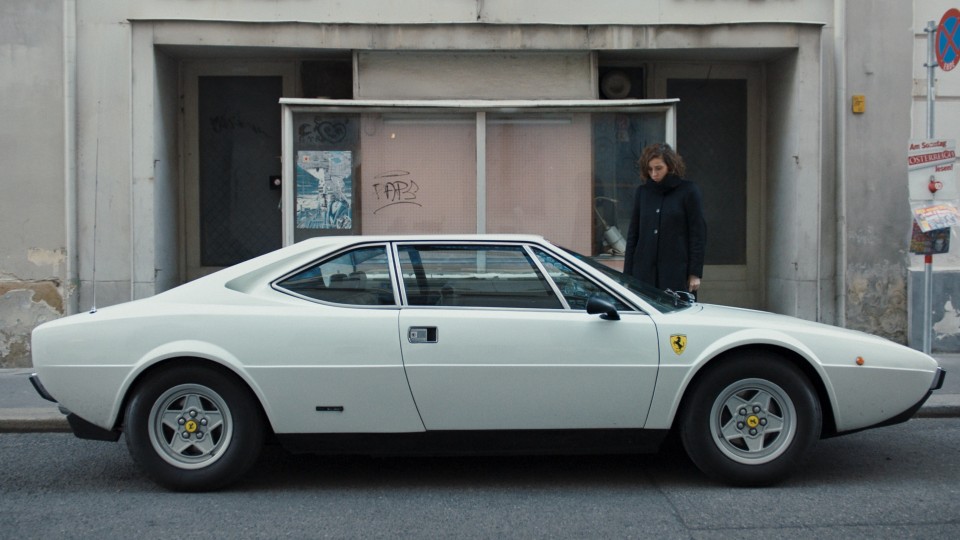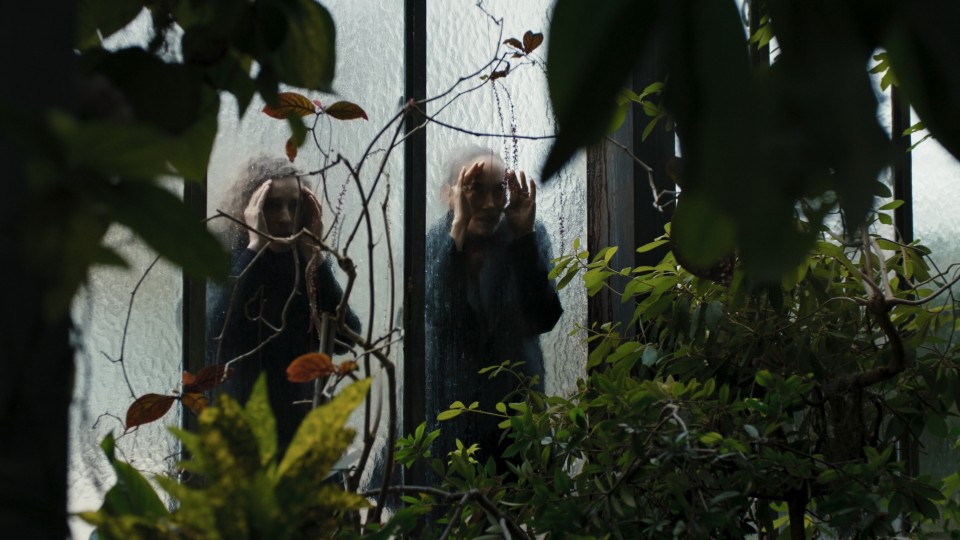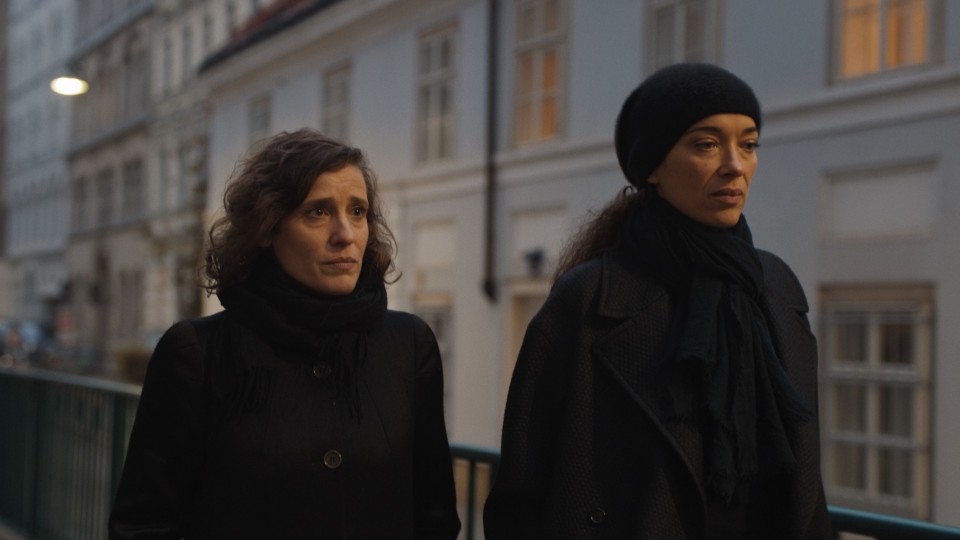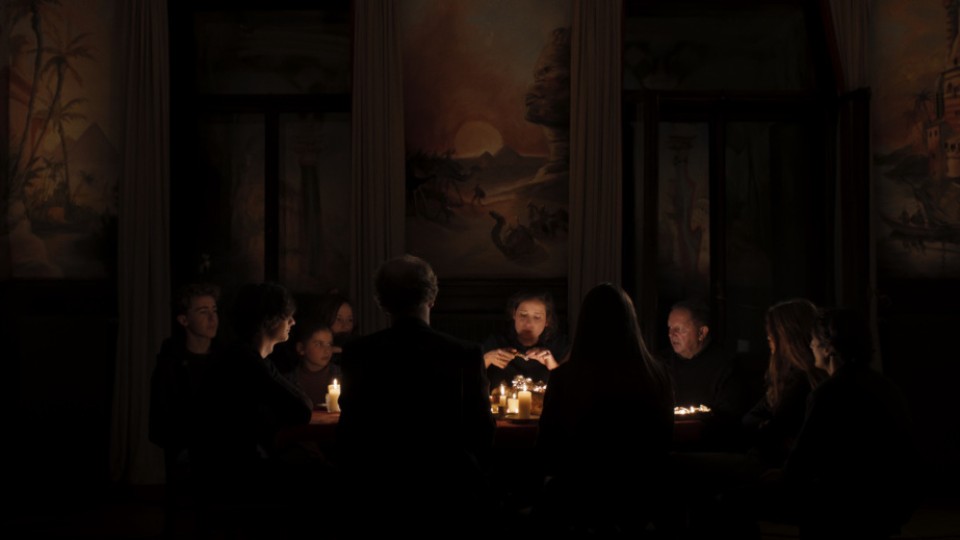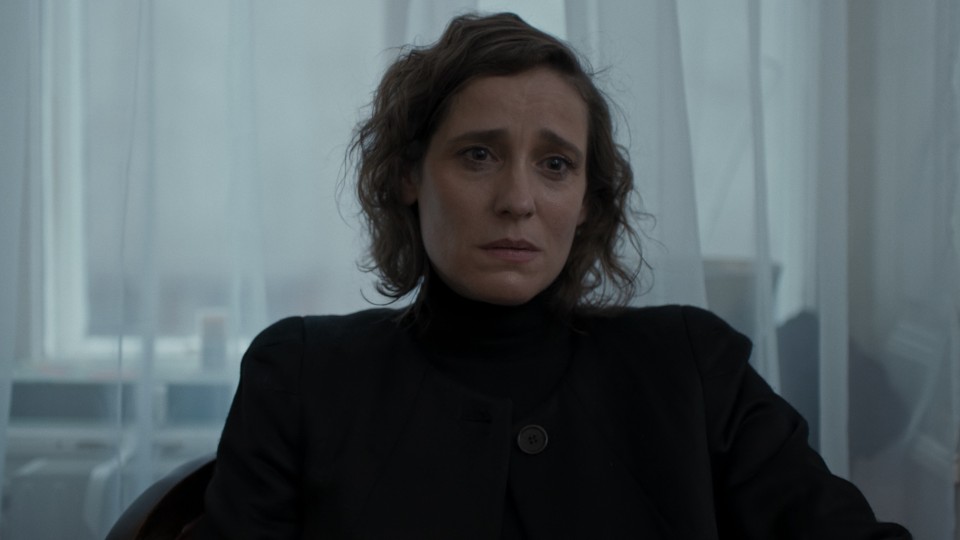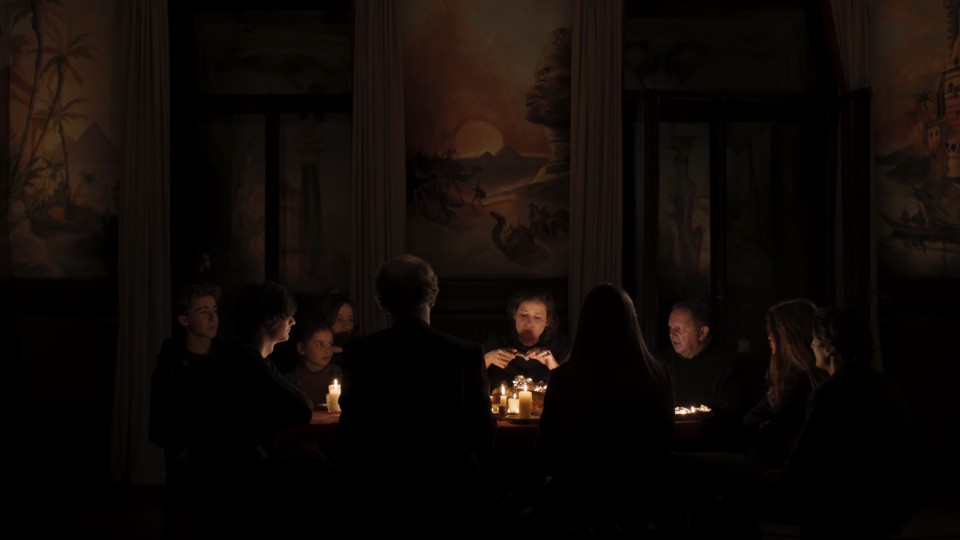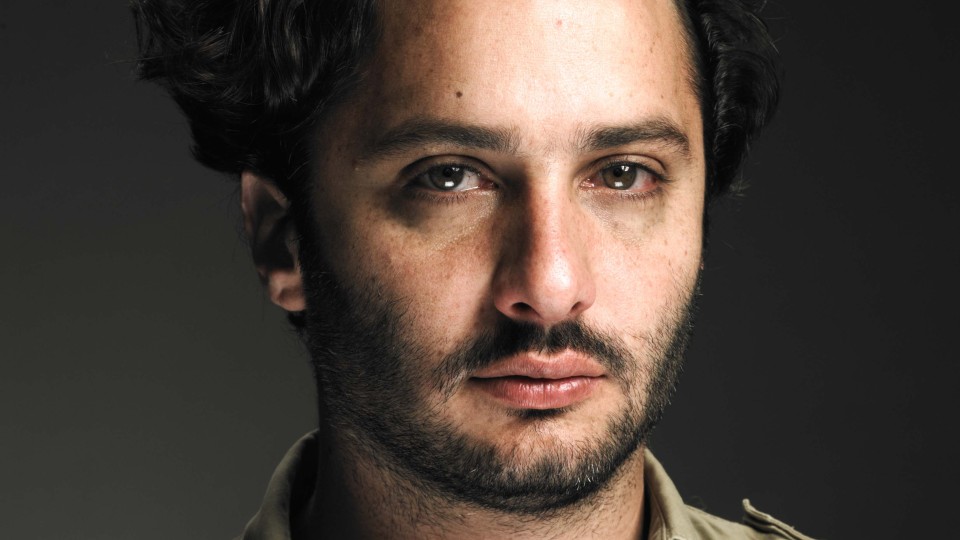Gastón Solnicki has a particular faible for Vienna, its sounds and its layers. In the first images of A LITTLE LOVE PACKAGE
he has captured for posterity the last hours when it was still permitted to enjoy a cigarette with one’s melange in a Viennese
café. And in a city where the vanished past never entirely dissolves, the Argentinian filmmaker begins his story together
with two women, one of whom intends to settle in Vienna. Just as the search for an apartment in Vienna develops into an associative
voyage, A LITTLE LOVE PACKAGE becomes an essay on remaining and passing by.
The first images of A LITTLE LOVE PACKAGE create a kind of a parallel to Introduzione all’Oscuro, the film you shot in 2017
in memory of Hans Hurch, but also as a homage to Vienna. Is Vienna per se a city that inspires you to reflect on a vanishing
world? What motivated you to shoot your new film in Vienna as well?
GASTÓN SOLNICKI: I’ve experienced how people react to Vienna – be it the parks and trees, its silence or the musical culture. It’s curious
to see how local people react to these films, since they are submerged in a city they find so natural. As for Buenos Aires
I learned through my friend Hans about the effect the city had on foreigners. He often expressed a link between Vienna and
Lisbon by the vast imperial past that got lost. Despite the fact that Buenos Aires and Vienna don’t really match in this aspect,
there was a strong connection that constituted our friendship, which began and developed during our respective visits to Buenos
Aires and Vienna. The very candid images of the city that we captured in Introduzione all’Oscuro can trigger strong emotions.
For me personally, Vienna is a very special place to visit and also to make films. It is like Cinecittà in the 50’s, but with
that atmosphere of horror and pre-war feeling that has been so present in all of my recent work.
How would you describe your working method, which seems to be infused by different cities that matter to you?
GASTÓN SOLNICKI: My film plays in Vienna where time is different. It is wonderful that you can feel all these eras at the same time. Vienna
is a place that kept evolving in a curious way with all its layers that are vividly present. That’s something that makes me
react strongly. My practice is reactive rather than about constructing a world of ideas. I don’t write much beforehand. I
very much like in that regard, von Sternberg’s quote, To frame is to remove things.
Introduzione all’Oscuro was a very spontaneous film. I was invited to Vienna to participate in a tribute to Hans Hurch and I had this epiphany that
I didn’t just want to come to show a film, but also wanted to make a film that could somehow crystallize our friendship and
the personality of Hans. A LITTLE LOVE PACKAGE is the attempt to go a bit deeper, come back to Vienna and do things with a
little more time. We ended up filming during the core of the pandemic, and not only that, November 2nd, 2020, the day of the
terrorist attack that occurred in Vienna, was our second day of shooting. There was not a friendly atmosphere in the city,
military and police searching for the terrorists, being in the streets was forbidden, people participating in the project
had to fly into Vienna from different parts of the world, it was completely uncertain whether any of us would be able to get
into the city.
It’s not a film made upon certainties or a hypothesis. I’m used to working that way. I consider this film as my second first
film, because I was always trying to imagine myself making fiction films – whatever that means – and I ended up being more
engaged with a documentary approach. This film allowed me for the first time to work with elements I hadn’t used before –
lighting, tracking shots, actors. It remained a challenge since I still didn’t work with a script. It is a very improvised
film, in this sense very much like my previous work, but it’s a more complex film. Vienna is still crucial. There’s one important
thing: In 2019, I was in Vienna to present Circumplector, a 2-minute-film, shot in Paris and Buenos Aires, also just a few days before a terrible event – the fire in the Notre Dame
cathedral. My previous films – there was one I made on Béla Bartók’s only Opera which was written right before the First World
War – often seem to have a connection with the end of an era or a sort of imminent crisis. During my stay in Vienna, I learned
that a law was about to come into place which would forbid smoking in public places. Somehow, I felt that it was a meaningful
event, the end of a certain lifestyle, of smoking in cafés, a really old tradition. I felt like filming this and somehow,
I managed to put a crew together thanks to my dear producer and friend Paolo Calamita who was very supportive and imaginative
in order to enable shooting within one day. We filmed in the Café Weidinger and at the Kleines Café and documented the last
hours of legal smoking in Viennese cafés, not knowing that only a year later – in a different context – breathing would be
at stake. It’s a documentary sequence that now opens the film – you see the last legal smoke in a café in Vienna. A year later
we returned to film A LITTLE LOVE PACKAGE.
You focus on certain elements that represent Vienna; the café is one of them. The one you chose is not one of the iconic cafés
of the first district but Café Weidinger, a very popular place which is located between the inner and the outer districts
of the city. Considering that you don’t write beforehand, how do you let yourself be guided and pick the stories to be in
your film?
GASTÓN SOLNICKI: I owe a lot to my friend, the Portuguese cinematographer Rui Pocas, who was not here then, but who convinced me to make a
feature film from these materials. He’s not only a master of cinema and light. We filmed Introduzione all’Oscuro in only 13
days, and he proved not only to be brilliant dealing with the technicalities, he impressed me by his capacity to let go of
things that may not function. He has this intuition of somebody who sort of knows that something might not work. Almost everything
we filmed for Introduzione all’Oscuro is in the film, we achieved a really rare ratio. And it’s also the case for A LITTLE
LOVE PACKAGE. Since we do not start with a narrative structure requiring certain elements to connect or develop things, we
had a great freedom. Talking about the film now seems strange for me, I’m not illustrating something I have not written or
conceived, I’d rather spontaneously capture what I like to call “filmic epiphanies“. They are at the center of my search.
That’s why it’s so important in our formal quest. But back to Café Weidinger: Logistics is always my biggest issue. How do
you guide people? What are we doing now? What are we doing tomorrow? How can we access places? During the lockdown it was
very curious to see how the city would open itself in a very unforeseeable manner. Shooting in the Kunsthistorisches Museum
for instance would have been impossible under normal circumstances. The same with Café Weidinger. Still, it is not a film
related to the pandemic. I kept as much distance as possible from these particular circumstances, but it is also a kind of
document since you see the empty city. We went to a whole number of cafés and then decided to go to Café Weidinger and film
all day there. We were a nice, very Latin cell of people coming from Greece, Argentina, Portugal. People were touched and
maybe therefore opened up in front of the camera. I think there was a strong need of human connection. The janitor from the
place I was staying came up with things that I wanted to film: this man with a spectacular, tender face and this beautiful
accent would come and bang my radiators with his hammer. That’s something touching about cinema: it offers people an opportunity
to open; random persons who are not at all related to acting learn that their face, or a moment of their time may have some
significance in the cinema. We worked with these little things as we moved through the city. I wanted to shoot outside the
first district, since Introduzione all’Oscuro had already focused on this area. I was interested in a different architecture.
There’s also a fur shop in the film, I’m drawn to this kind of things because they haven’t changed in 50 years. As you say,
there might be a sense of nostalgia, of an era that is coming to an end.
I have the impression that you moved through the spaces you chose, open and ready to react at every moment. Still, there’s
also a story between two women and other narrative elements that you may have written in a more detailed way. What was something
you were sure about before starting to shoot?
GASTÓN SOLNICKI: To be honest, I didn’t have very many certainties before starting to shoot. One of my biggest worries was the fact that I
hadn’t worked with professional actresses before. Angeliki Papoulia is an actress I wanted to work with, we met some years
ago in a jury in Karlovy Vary and had an immediate connection, it was a real honor to work with her and also a challenge.
Carmen Chaplin is a good friend, I met her when I was studying in New York. She is also spectacularly talented. They generously
brought very much to the film thanks to their courage. I had no idea how the two personalities would relate, I just wanted
to give it a chance. I only had a very faint notion on the search for an apartment. A Real Estate Drama.
This search of an apartment in Vienna in order to invest money that seemingly has to be spent raises fundamental questions
such as What is a good place to live? What is a meaningful way to spend money? You’re structuring the film with symbols drawn
with a piece of chalk on a blackboard – the money, the brains, the heart. Are these symbols related to the ideas that guided
you?
GASTON SOLNICKI: There are symbols, punctuations, drawings
Definitely they have to do with these questions. I’m impressed about how many
of my concerns – things that worry me and fascinate me – are represented in the film. At first, things do not come in a very
linear way. For instance, the cheese which, I thought, had nothing to do with Vienna. But once you start, connections evolve
in a curious way. The idea of the value of things or of money has also been present in other of my films. We had no rehearsals,
we just started off improvising; often we would just go to a location that I wanted to film and things would come up.
Family is another very central theme in LITTLE LOVE PACKAGE. How important was it for you to shoot with real families?
GASTÓN SOLNICKI: Funny in a certain way. After my film Papirosen which deals with my family in an exorcistic way, I wanted to walk away from
the subject. Somehow it seems to haunt me. It wasn’t an issue at the beginning, but somehow a cryptical celebration of family
and tradition sneaked in. The film took this direction in order to combine different things. There are a lot of characters,
it’s not easy to find the bonds which will be different ones for different audiences. The film will be perceived in a very
subjective way. But as a matter of fact there are many families in the film.
Children play a very important role. They are on the one hand part of the family theme, they also reveal another core issue
of your film: the passing on from one generation to the next. What are the things that live on and the things that will disappear?
GASTÓN SOLNICKI: Absolutely. I’d like to associate this idea of passing on, also to one of my previous films, a documentary on the composer
Mauricio Kagel. It was about music, but also about keeping certain crafts alive. He told us how he learned certain things
from others and wanted to pass them on. I specially think about a teenage boy, the son of an Argentinian friend. At the time
we filmed, Buenos Aires had been in lockdown for over 4 months. This teenager particularly suffered from this isolation. I
thought, he could come over to Vienna and help give us a hand. When I suggested him to join us, he was all enthusiastic about
it. At an early stage of the shooting we realized that there was something about him, due to his contemporary clothes and
gestures. Apart from that you cannot really situate the film right in time. The children in A LITTLE LOVE PACKAGE are witnessing
or discovering what the world used to be like. A fire that is still alive.
As you just mentioned, music is always an essential part of your films; in A LITTLE LOVE PACKAGE I have the impression that
you also put a focus on sounds. Are they even a prevailing motif to shoot something?
GASTÓN SOLNICKI: Indeed. The parquet floor in the Kunsthistorisches Museum, sounds definitely as it sounds in the film. It’s spectacular.
And one of the feedbacks I had in Buenos Aires was that we were exaggerating with the silence. Buenos Aires is a very loud
city. People in Vienna aren’t noisy, and during our shooting the city was empty, we had to do with a kind of snow-like acoustics.
Locations and their soundscapes are very important to me. This is not only a metaphor, what I find fascinating about sound,
goes back to an era before cinema. Very often it’s about these notions of how sounds are placed and it has a lot to do with
a certain expression of music that I’m really not interested in, I’m much more interested in the idea of counterpoint and
polyphony. The locations we filmed in, were also sources of specific sounds. They have the capacity to be very abstract and
ethereal on the one hand and also physical on the other. My interest grows into this specificity. So much of my work is based
on it. Not a given library sound, but that specific sound in our location. These sounds can trigger emotions. Of course, there
is a strong relation between non-linearity and the way sound functions. It is a different way to create tension and to find
our structure. Sounds are very important for the whole process. We found most of the sounds during the shooting, only very
few in post-production. We also had a great pianist and friend, Han-Gyeol play for us. With Mario Bellatin, the Mexican writer
and friend, we looked for a kind of narration, to find a way to help contain and expand the material. We ended very far away
from it, guided by his capacity to call for prayer. My films usually are quite compact, I don’t want to make long and boring
films, I am aware of the limits of what I can do without a script and the low ceiling of improvised dialogues. I challenge
the viewer to find a way to relate with these films. Cinema has a great capacity to lure you, even if you first don’t quite
understand what to do with these things.
How did the “brains” chapter and the scientific aspect of the film come up?
GASTÓN SOLNICKI: One of the characters is a neuroscientist, Dr. Daniel Margulies. He seems as a very ghostly, timeless resident of Vienna.
We were interested in digging more into his world and in doing brain scans but we didn’t manage to get into the hospital.
It had to do with his world and we found a connection to the Naturhistorisches Museum which is also a location we are very
fond of.
Are there ghosts in your movies?
GASTÓN SOLNICKI: Yes, very many. There are ghosts in Vienna. I dreamed with one upon arriving in Europe a few weeks ago. In Vienna you go
to the basement and you start to see all those layers. Even in the cheese cellar building you find something that dates back
to the 19th century and another room back to the 13th.
How can we imagine your editing process when you have to deal with all the intuitively collected material?
GASTÓN SOLNICKI: Our editing job is to find out how the emotional logic works. In the editing stage we endlessly move things around until we
understand their function. That’s the reason why I show my work a lot in the course of this process in order to understand
what is happening. I think that comes from my theatre background. It’s not evident that everybody will make the same associations.
There’s a lot of ways to find access, to be impacted by the material. When we were filming we just tried to pull in things
that we were interested in: brains, cheese, money, the shoemaker, the little boats. You don’t get everything you want, but
somehow there is a logic which comes from somebody, personal intuitions and connections. None of the images is an illustration
of an idea. There’s this wonderful quote by Grisey, whose music stars in the film. No longer composing with notes but with
sounds.
How about the title A LITTLE LOVE PACKAGE?
GASTÓN SOLNICKI: A little love package from the old world, to let you know that we are still alive.
Interview: Karin Schiefer
October 2021

